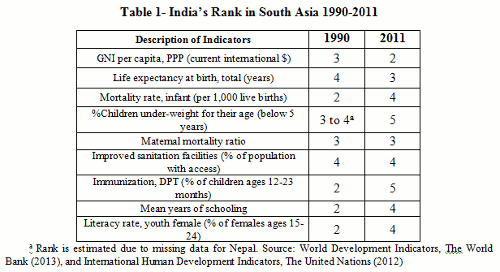In 2010 only about one-third of its citizens had access to improved sanitation facilities and while its neighbours (with the exception of Pakistan), have achieved almost universal DPT immunization coverage of children aged two years India barely increased its immunization rate.
Furthermore, India’s efforts in curbing maternal deaths pale in comparison to Nepal’s impressive achievements in that area. Nepal’s maternal mortality ratio was 170 in 2010, compared to India’s 200. India has also fallen behind in the schooling indicators such as average years of schooling and youth female literacy rates. Bangladesh has overtaken India in both measures despite being some way behind a few decades earlier.

Advertisement
Table 1 presents India’s ranking in South Asia on the various social indicators in 1990 and in 2011. On two indicators, per capita income and life expectancy, India’s ranking improved. But with respect to other indicators, India’s rank has actually fallen.
Its rate of social development has lagged behind much poorer Nepal and Bangladesh. During the 1990s, India was ranked near the top-two in most of the indicators. Two decades later and notwithstanding its stellar economic performance, India was in the bottom-two and for some indicators (proportion of underweight children and immunization rates) it is the worst performing country.
Despite Bangladesh’s per capita income being almost half of India’s, it performed much better in most of the basic indicators and it has exhibited the most dramatic improvements in basic living standards among the five countries. Nepal has also caught up with India and has surpassed India in maternal mortality, immunization rates, youth female literacy and life expectancy at birth and this in spite of Nepal’s per capita income being one-third of India’s.
From these trends it appears that compared to its much poorer neighbours India has performed poorly and has gone backwards.
Concluding Remarks:Indicators of social well-being did improve in the period of India’s rapid economic growth. But when examined in the context of its South Asian neighbours, India has gone backward not forward.
Our analysis confirms Dreze and Sen’s findings that with respect to the indicators examined here; India’s ranking has slipped badly in comparison to its South Asian neighbours. There appears to be a disconnect between the rate of economic growth and improvement in living conditions. Economists take the causal relationship of these two indicators as given but the case of India and its neighbours tells us something different.
Advertisement
The realm of civil society organizations and NGOs know well that growth does not translate into better living conditions and human development as growth is not equal. It would appear that the planning and implementation of public policies seeking to advance collective wellbeing is more important than the scale or rate of economic growth.
Discuss in our Forums
See what other readers are saying about this article!
Click here to read & post comments.
3 posts so far.
About the Authors
Riaz Hassan is Australian Professorial Fellow and Emeritus Professor at Flinders University, Adelaide, Australia and Visiting Research Professor at the Institute of South Asian Studies of National University of Singapore. His most recent books are: Islam and Society: Sociological Explorations (Melbourne University Press 2013) and, Life as a Weapon: The Global Rise of Suicide Bombings, (Routledge January 2014).
Ishraq Ahmad is a former Research Associate at the Institute of South Asian Studies.